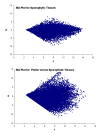Genomic expression profiling of mature soybean (Glycine max) pollen
- PMID: 19265555
- PMCID: PMC2660330
- DOI: 10.1186/1471-2229-9-25
Genomic expression profiling of mature soybean (Glycine max) pollen
Abstract
Background: Pollen, the male partner in the reproduction of flowering plants, comprises either two or three cells at maturity. The current knowledge of the pollen transcriptome is limited to the model plant systems Arabidopsis thaliana and Oryza sativa which have tri-cellular pollen grains at maturity. Comparative studies on pollen of other genera, particularly crop plants, are needed to understand the pollen gene networks that are subject to functional and evolutionary conservation. In this study, we used the Affymetrix Soybean GeneChip to perform transcriptional profiling on mature bi-cellular soybean pollen.
Results: Compared to the sporophyte transcriptome, the soybean pollen transcriptome revealed a restricted and unique repertoire of genes, with a significantly greater proportion of specifically expressed genes than is found in the sporophyte tissue. Comparative analysis shows that, among the 37,500 soybean transcripts addressed in this study, 10,299 transcripts (27.46%) are expressed in pollen. Of the pollen-expressed sequences, about 9,489 (92.13%) are also expressed in sporophytic tissues, and 810 (7.87%) are selectively expressed in pollen. Overall, the soybean pollen transcriptome shows an enrichment of transcription factors (mostly zinc finger family proteins), signal recognition receptors, transporters, heat shock-related proteins and members of the ubiquitin proteasome proteolytic pathway.
Conclusion: This is the first report of a soybean pollen transcriptional profile. These data extend our current knowledge regarding regulatory pathways that govern the gene regulation and development of pollen. A comparison between transcription factors up-regulated in soybean and those in Arabidopsis revealed some divergence in the numbers and kinds of regulatory proteins expressed in both species.
Figures




Similar articles
-
Genome-scale analysis and comparison of gene expression profiles in developing and germinated pollen in Oryza sativa.BMC Genomics. 2010 May 28;11:338. doi: 10.1186/1471-2164-11-338. BMC Genomics. 2010. PMID: 20507633 Free PMC article.
-
Gene family analysis of the Arabidopsis pollen transcriptome reveals biological implications for cell growth, division control, and gene expression regulation.Plant Physiol. 2005 Jun;138(2):744-56. doi: 10.1104/pp.104.057935. Epub 2005 May 20. Plant Physiol. 2005. PMID: 15908605 Free PMC article.
-
Transcriptomes of Plant Gametophytes Have a Higher Proportion of Rapidly Evolving and Young Genes than Sporophytes.Mol Biol Evol. 2016 Jul;33(7):1669-78. doi: 10.1093/molbev/msw044. Epub 2016 Mar 8. Mol Biol Evol. 2016. PMID: 26956888 Free PMC article.
-
A decade of pollen transcriptomics.Plant Reprod. 2015 Jun;28(2):73-89. doi: 10.1007/s00497-015-0261-7. Epub 2015 Mar 12. Plant Reprod. 2015. PMID: 25761645 Free PMC article. Review.
-
Transcription Factors and Their Regulatory Roles in the Male Gametophyte Development of Flowering Plants.Int J Mol Sci. 2024 Jan 1;25(1):566. doi: 10.3390/ijms25010566. Int J Mol Sci. 2024. PMID: 38203741 Free PMC article. Review.
Cited by
-
Acclimation to high temperature during pollen development.Plant Reprod. 2016 Jun;29(1-2):107-18. doi: 10.1007/s00497-016-0282-x. Epub 2016 Apr 11. Plant Reprod. 2016. PMID: 27067439 Free PMC article. Review.
-
Digital Gene Expression Analysis of Populus simonii × P. nigra Pollen Germination and Tube Growth.Front Plant Sci. 2016 Jun 15;7:825. doi: 10.3389/fpls.2016.00825. eCollection 2016. Front Plant Sci. 2016. PMID: 27379121 Free PMC article.
-
Comprehensive analysis of tobacco pollen transcriptome unveils common pathways in polar cell expansion and underlying heterochronic shift during spermatogenesis.BMC Plant Biol. 2012 Feb 16;12:24. doi: 10.1186/1471-2229-12-24. BMC Plant Biol. 2012. PMID: 22340370 Free PMC article.
-
Circular RNAs Repertoire and Expression Profile during Brassica rapa Pollen Development.Int J Mol Sci. 2021 Sep 24;22(19):10297. doi: 10.3390/ijms221910297. Int J Mol Sci. 2021. PMID: 34638635 Free PMC article.
-
How Do Pollen Allergens Sensitize?Front Mol Biosci. 2022 Jun 16;9:900533. doi: 10.3389/fmolb.2022.900533. eCollection 2022. Front Mol Biosci. 2022. PMID: 35782860 Free PMC article. Review.
References
Publication types
MeSH terms
Substances
LinkOut - more resources
Full Text Sources
Other Literature Sources
Molecular Biology Databases

